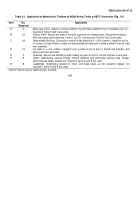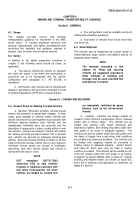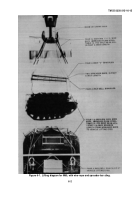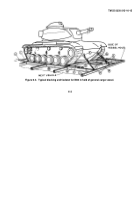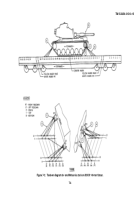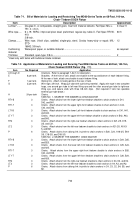TM-55-2350-215-10-15 - Page 42 of 66
TM 55-2350-215-10-15
CHAPTER 7
RAIL TRANSPORTABILITY GUIDANCE
Section I.
GENERAL
7-1.
Scope
This chapter provides rail transportability guidance for
movement of the M60-series tank.
It includes technical
and physical characteristics and safety considerations
and prescribes the materials and guidance required to
prepare, load, tie down, and unload the vehicle.
7-2.
Maximum Utilization of Railcars
Additional cargo, as approved by the activity offering the
items for transport, may be transported on the same
railcar with the tank.
Section II.
TRANSPORT ON CONUS RAILWAYS
7-3.
General.
The transportability guidance contained in this section is
applicable when the vehicle is transported on CONUS
railways.
Consideration is given to single and multiple
movements for the types of flatcars normally used in the
movement of this vehicle.
The vehicle, when loaded on
a suitable flatcar, can be transported without
sectionalization or major disassembly.
The M60-series
tank exceeds width limits for unrestricted movement and
will require special routing as determined by officials of
the railroad accepting the load.
7-4.
Preparation for loading.
a.
M60-Series Tank.
Preparation of the M60-
series tank will vary among loads to be transported over
various routes on different rail equipment and with
different restraint procedures.
When tanks are moved
short distances over a single railroad line, preparation is
minimal.
When tanks are moved long distances through
interchange points of several railroad lines, preparation
must be adequate to assure safe and economic delivery
at their destination.
loading procedures are described in
paragraphs 7-5 through 7-9.
b.
Sixty-Eight Foot, 140-Ton, Chain-Tiedown
DODX Flatcar.
(1)
The 140-ton flatcar is a heavy-duty, six-
axle flatcar with a loading deck 816 inches (20.73 m)
long and 123 inches (3.12 m) wide except for the ends,
which are tapered to 117 inches (2.97 m).
Its metal
deck has four lengthwise channels holding 48 chain
tiedown assemblies.
The two outboard channels
marked A and D are 34 inches (.86 m) from the
centerline of the flatcar.
The two inboard channels
marked B and C are 239/16 inches (.60 m) from the
centerline of the flatcar.
Each channel has 44 primary
tiedown positions marked on the deck of the flatcar.
Between each marked position are four more positions;
each is 3 inches (.08 m) apart.
(2)
Each chain tiedown assembly is made
up of an anchor, which is movable in the channels; a
turnbuckle; a compression unit, and a 1/2-inch alloy-
steel chain, 8 feet (2.44 m) long, with an open hook on
the load attachment end and a grabhook on the
turnbuckle end.
(3)
Before loading, the chain anchors must
be locked at proper locations.
With the use of the
turnbuckle as a handle, the chain anchor must be slid
along the bottom of the channel and lifted to the
required locking location in the channel.
For the anchor
to be locked in position, the tabs at each end of the
anchor must be rotated up and moved sideways to
retract the movable pins in the anchor, and the anchor
must be lifted to completely seat in the channel notches.
This position must be held while the tabs at each end of
the chain anchor are moved sideways, to extend the
movable pins so they rest on top of the channel.
The
tabs must be rotated down and into the recess keeper.
Each turnbuckle must be extended to its mechanical
stop.
(4)
Each tiedown chain (and its fittings) to
be used be inspected for visible breaks, cracks, gouges,
open welds, or deformed components.
Special attention
must be given to the connector link that attaches the
chain to the anchor fitting.
If defects are found, the
chain or fitting must be replaced.
(a)
Flatcars manufactured by Fruit
Growers Express Company are equipped with chains
that have a sliding hook at the free end of the chain.
If
all components are free of visible damage, the eight-link
segment next to the free end of the chain must be
compared with the eight-link segment
7-1
Back to Top

